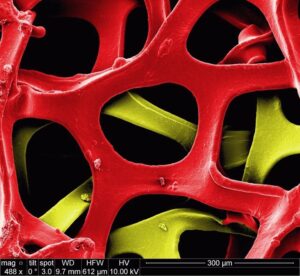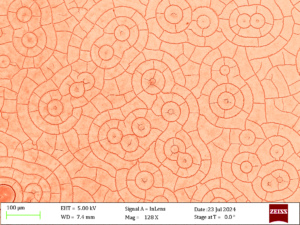Congratulations to the winners of the STS Elionix Scientific Image competition of Q4 2024!
The STS Elionix Scientific Image competition allows us to showcase the creative side of the researchers here at Tyndall. They share scientific images from their research which they have discovered to be visually striking or informative to the technically excellent.
The judges for the Q4 competition were Prof. William Scanlon, CEO; Dr Graeme Maxwell, Head of Specialty Products & Services, Dr Daniela Iacopino, Researcher, MNS, and Peter Smyth, Commercial Director.
The exceptional quality and creativity in the images led to the votes being cast for the following winners: Rupa Ranjani Palanisamy (Nickel Web), Ehren Dixon (Sahara’s Lake) and Jesus Hernan Mendoza-Casto, Tomasz Piwonski & Artem Vorobev (Night in Metacity).
The winners are each awarded a €100 Me2You Gift Card, kindly sponsored by STS Elionix.
Nickel Web
Rupa Ranjani Palanisamy, Advanced Energy Materials Group

This SEM image showcases the intricate structure of a nickel foam substrate, captured at a microscopic level.
The interconnected design reminds one of a spider’s web, exemplifying the fascinating patterns created during fabrication. This work of fabricating electrodes is for the “TRANSLATE” project, focusing on the innovative conversion of waste heat to electricity.
Using a hydrothermal method, the metal chalcogenides are grown directly onto the Ni Foam substrate. This distinctive architecture allows for strong adhesion of the materials to the substrate, akin to how a spider web secures its prey. Such robust integration significantly enhances the overall electrochemical performance, making this electrode highly suitable for both supercapacitor applications and heat-to-electricity conversion. The “Nickel Web” prototype stands as a promising candidate for advanced energy storage solutions, paving the way for more sustainable technologies.
Sahara’s Lake
Ehren Dixon, Electrochemical Materials & Energy Group

In electroplating at Tyndall, the deposition process may occasionally go off track, but the outcomes can still be intriguing.
Electroplated layers have internal stress, with the layer’s atoms pushing and pulling at each other. Too much stress and your layer will crack! It’s never nice to find these cracks in your deposits, however, sometimes these micro-fractures lead to some interesting design and patterns in your deposit.
Coloured in a red hue, this cracked deposit looks similar to the dry lake beds in the infamous Sahara desert.
Night in Metacity
Jesus Hernan Mendoza-Casto, Tomasz Piwonski & Artem Vorobev, Photonics: CAPPA Group

A rectangular-pillar-based metadeflector was fabricated at Tyndall on a Germanium platform.
The nanostructures were optimised for compatibility with mass production via photolithographic techniques.
The device was designed to demonstrate beam-steering capabilities to enable efficient control of mid-infrared wavelength light for spectroscopy applications. Obtained metastructures will be used in the Enhanced Selectivity VOC Detection Using Novel GC-QEPAS, (EVOQUE) project funded by the European Union’s Horizon Europe research and innovation programme.
